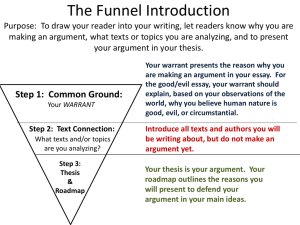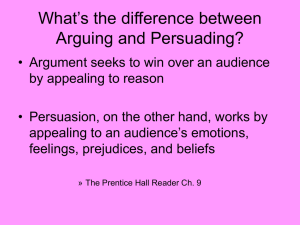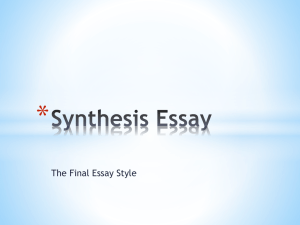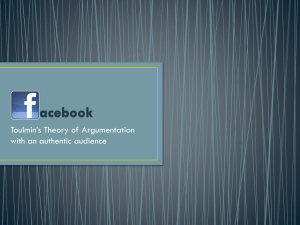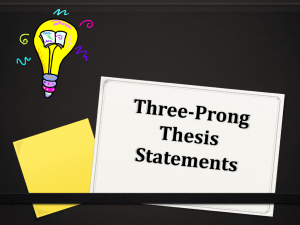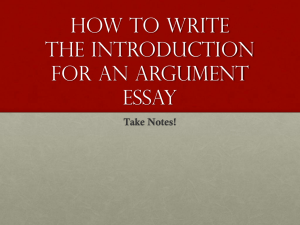Critical Writing - Student Learning Development
advertisement
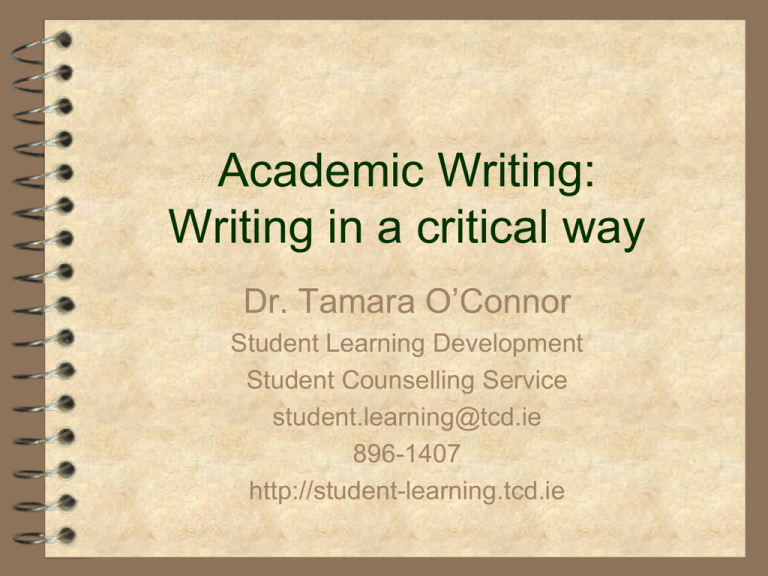
Academic Writing: Writing in a critical way Dr. Tamara O’Connor Student Learning Development Student Counselling Service student.learning@tcd.ie 896-1407 http://student-learning.tcd.ie Learning Objectives Understand what is meant by academic writing Awareness of academic conventions and practices Learn how to develop argument in your writing Awareness of plagiarism and appropriate use of references/citations Resources Writing in an academic way Being critical and analytical Using language in a precise & subject- specific way Adopting a position or claim - thesis Drawing on and citing a range of authors & arguments to support Remaining objective Model to Generate Critical Thinking Description Who? Where? When? How? What? Analysis Topic Why? What next? So what? What if? Evaluation Learning Development University of Plymouth What is critical writing? Argument – Evaluate & weigh up ideas – State point of view – Consider available evidence – Possible counter arguments – Claim that is proven throughout the paper Opinion – Point of view – Lack of supporting evidence – Personal feelings and views Steps in constructing argument Analyse topic Write down your working thesis – Your point of view in relation to topic – Keep thesis prominent What is your argument/position? Topic Usually has premise invites you to take a position Do you agree or disagree? Key concepts, theories, model, practice or idea Some Examples: “In the last 20 years, rates of divorce have risen significantly in Western countries. Critically analyse some of the different explanations given for this phenomenon. In your discussion you should consider what implications these explanations might have for social policy.” [From www.monash.edu.au/lls/llonline/writing/general/essay/essay-topic/index.xml] “The concept of identity is central to the conceptualisation of one of the most complex and fascinating of human creations, the work organisation. Gioia (1998).” Discuss. [From Neville (2005)] “Italy on the eve of 1860 has often been described as an unlikely nation. Why?” [From http://learning.uow.edu.au/resources/] Thesis Statements Which thesis statement is the most effective for an argument about the need for V-chips in television sets? Parents, often too busy to watch television shows with their families, can monitor their children’s viewing habits with the aid of the V-chip. To help parents monitor their children’s viewing habits, the V-chip should be a required feature for television sets sold in the U.S. This paper will describe a V-chip and examine the uses of the V-chip in American-made television sets. Thesis Statement PARAGRAPH 1 The Black Death (otherwise known as the Bubonic Plague) first appeared in Europe in the 1340s. Spread by rodents and fleas, the infection is said to have 'carried off' a third of Europe's population. Plague causes fever and a painful swelling of the lymph glands called buboes. The disease also causes spots on the skin that are red at first and then turn black. PARAGRAPH 2 The Black Death of 1348 coincided with fundamental changes in the social framework of the later Middle Ages. However, the disease alone was not responsible for these changes. Rather, it is necessary to consider a number of economic, agricultural and health factors in assessing the transformation of late medieval society. Steps in constructing argument Analyse topic Write down your working thesis – Your point of view in relation to topic – Keep thesis prominent Organise your argument Organising your argument Title Introduction – Thesis statement – Background – Plan of essay Body Paragraphs – Constructing Topic Sentences – Building Main Points – Countering the Opposition Conclusion From Purdue University Writing Lab http://owl.english.purdue.edu/ Introduction (Carrradice, Shankland & Beail 2002: 17) Due to social and political changes in the UK more family caregivers for people with dementia are being referred to mental health nurses for assessment and treatment. Caregiving for a member of the family who is suffering from dementia can be stressful (Schulz et al., 1990). Accepting the view that theory should guide practice ( Holdsworth, 1995), it is recommended that assessments of carers should be based on a theoretical understanding of the stress process of caring. However, nurse training does not provide the required theoretical knowledge to guide the nurses’ work ( Sheppard, 1991). Sheppard (1991) explained that the gap between what nurses know and the demands of their role exists because nursing theory is inadequate. This means that nurses’ work is developed by trial and error experience, rather than theoretical training. One concern is that if the theoretical models adopted by the nurses are limited and fragmentary as suggested Sheppard (1991), then the practice may mirror this. Without comprehensive assessment based on some understanding of the caregiving process, it is unlikely that treatments will be adequately targeted and this may be reflected in poor treatment outcomes ( Nolan et al., 1994). Introduction A major change that has occurred in the Western family is an increased incidence in divorce. Whereas in the past, divorce was a relatively rare occurrence, in recent times it has become quite commonplace. This change is borne out clearly in census figures. For example thirty years ago in Australia, only one marriage in ten ended in divorce; nowadays the figure is more than one in three (Australian Bureau of Statistics, 1996: p.45). A consequence of this change has been a substantial increase in the number of single parent families and the attendant problems that this brings (Kilmartin, 1997). An important issue for sociologists, and indeed for all of society, is why these changes in marital patterns have occurred. In this essay I will seek to critically examine a number of sociological explanations for the 'divorce phenomenon' and also consider the social policy implications that each explanation carries with it. It will be argued that the best explanations are to be found within a broad socio-economic framework. From: www.monash.edu.au/lls/llonline/writing/general/essay/sample-essay/index.xml Structure your argument Reasons for and evidence/Reasons against and evidence Compare & contrast Outline of points Handouts Try it! Introduction: Main themes: Areas to be compare and contrast A Similarities 1 2 3 4 Differences 1 2 3 4 Significance of these Conclusion: B Steps in constructing argument Analyse topic Write down your working thesis – Your point of view in relation to topic – Keep thesis prominent Organise your argument Develop argument Develop your argument Use body paragraphs & topic sentences Use source material – reliable evidence Show line of reasoning – link points – central guiding line Show awareness of complexities – Counter arguments, relativism Your conclusions – based on evidence – No new claims Paragraphs Points to support your thesis / theme / argument Series of sentences – Topic sentence – Supporting sentences Coherent Common theme – one idea or topic ONLY Main idea in one paragraph flows logically into the next (O’Sullivan & Cleary, 2010) Steps in constructing argument Analyse topic Write down your working thesis – Your point of view in relation to topic – Keep thesis prominent Organise your argument Develop argument Document points and claims One type of explanation for rising divorce has focused on changes in laws relating to marriage. [Topic sentence] For example, Bilton, Bonnett and Jones (1987) argue that increased rates of divorce do not necessarily indicate that families are now more unstable. It is possible, they claim, that there has always been a degree of marital instability. [Evidence] They suggest that changes in the law have been significant, because they have provided unhappily married couples with 'access to a legal solution to pre-existent marital problems' (p.301). Bilton et al. therefore believe that changes in divorce rates can be best explained in terms of changes in the legal system. [Further support] The problem with this type of explanation however, is that it does not consider why these laws have changed in the first place. It could be argued that reforms to family law, as well as the increased rate of divorce that has accompanied them, are the product of more fundamental changes in society. [Conclusion] From: www.monash.edu.au/lls/llonline/writing/general/essay/sample-essay/index.xml Building up your argument Failure to conceptualise carer stress in detail is likely to impact on the assessment process (Nolan & Grant, 1996). [claim] Because assessment is crucial to choosing the most appropriate treatment, if the assessment is unsophisticated in some areas, then the treatment decisions may be flawed (Nolan et al, 1994). [evidence/explanation] Research on outcomes of nursing interventions has suggested that they are not efficacious (Sheppard, 1991). [Further evidence/elaboration] These findings have been attributed to a lack of theoretical models guiding their work (Matthew, 1990) [concluding comment] (Carradice et al. 2002:17) Signposting your line of reasoning Link points Indicator words for claims – Therefore, thus, hence, so, as a result Indicator words for reasons – Because, since, on account of, for, in view of, for the reason that Indicator words additive/adversative – Finally, in addition, similarly – On the other hand, however, although, while Cohesion & Flow Parallelism – similar sentence patterns “One explanation for increasing rates of anorexia is... “Another explanation for increasing rates… Repetition of key words from sentence to next sentence Given-New – refer to previous topic then introduce new topic Prediction – last sentence predicts next paragraph From Center for Writing http:writing.umn.edu Steps in constructing argument Analyse topic Write down your working thesis – Your point of view in relation to topic – Keep thesis prominent Organise your argument Develop argument Document points and claims Reference or bibliography Reporting the work of others Making use of the ideas of other people is one of the most important aspects of academic writing because it shows awareness of other people’s work; it shows that you can use their ideas and findings; it shows you have read and understood the material you are reading; it shows where your contribution fits in; it supports the points you are making. (Gillet 2008, in O’Sullivan & Cleary 2010) References Why? Credit sources of information & ideas Reader can locate for further information if required Validate arguments Increase and spread knowledge Show depth, breadth & quality of your reading! Referring to sources Paraphrase Integrate quotes Level of endorsement – claim, suggest affirm, agree, confirm www.phrasebank.manchester.ac.uk Further information http://owl.english.purdue.edu http://www.learnhigher.ac.uk http://writing.umn.edu Linking words: http://www.unisanet.unisa.edu.au/Resources/la/Quick Clicks%20Repository/LC_worksheet_linking%20word s.pdf http://www.learningdevelopment.plymouth.ac. uk/wrasse/ - samples http:/www.phrasebank.manchester.ac.uk Crème & Lea (1997). Writing at university. References Carradice A., Shankland M.C. & Beail, N. (2002) A qualitative study of the theoretical models used by UK mental health nurses to guide their assessments with family caregivers of people with dementia. International Journal of Nursing Studies 39 (1), 17-26. Kunka J.L. (2000). Organizing your argument. Purdue University Writing Lab, Purdue. Retrieved from http://owl.english.purdue.edu on16 March 2009. Neville, C. (2005). Critical analysis. Bradford: Effective Learning Service, University of Bradford, School of Management. Retrieved from http://www.brad.ac.uk/management/els/resources/writingskills/critical-analysis/ O’Sullivan, I. & Cleary, L. (2010). NS 4016 Writing the literature critique 2. Retrieved from http://www2.ul.ie/pdf/902111753.pdf on 25 January 2011. Our details • Website: http://student-learning.tcd.ie • Email: student.learning@tcd.ie • Facebook: facebook.com/sldtcd • Twitter: twitter.com/StudentLearnin1 • Phone: 01-8961407
